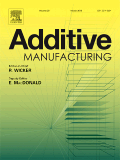Article by Sunil Bhandari, Roberto A. Lopez-Anido, Douglas J. Gardner published in Additive Manufacturing
 An article by PhD student Sunil Bhandari, titled Enhancing the interlayer tensile strength of 3D printed short carbon fiber reinforced PETG and PLA composites via annealing, has been published on the website of the Additive Manufacturing journal by Elsevier.
An article by PhD student Sunil Bhandari, titled Enhancing the interlayer tensile strength of 3D printed short carbon fiber reinforced PETG and PLA composites via annealing, has been published on the website of the Additive Manufacturing journal by Elsevier.
The article, which was also coauthored by Doctors Roberto A. Lopez-Anido and Douglas Gardner, acts as the first chapter of Bhandari’s dissertation. The research within it was partially funded by the Transportation Infrastructure Durability Center at the University of Maine.
The following is the abstract for the article:
Previous studies have shown that 3D printed composites exhibit an orthotropic nature with inherently lower interlayer mechanical properties. This research work is an attempt to improve the interlayer tensile strength of extrusion-based 3D printed composites. Annealing was identified as a suitable post-processing method and was the focus of this study. Two distinct thermoplastic polymers, which are common in 3D printing, were selected to study the enhancement of interlayer tensile strength of composites by additive manufacturing: a) an amorphous polyethylene terephthalate-glycol (PETG), and b) a semi-crystalline poly (lactic acid) (PLA). It was determined that short carbon fiber reinforced composites have lower interlayer tensile strength than the corresponding neat polymers in 3D printed parts. This reduction in mechanical performance was attributable to an increase in melt viscosity and the consequential slower interlayer diffusion bonding. However, the reduction in interlayer tensile strength could be recovered by post-processing when the annealing temperature was higher than the glass transition temperature of the amorphous polymer. In the case of the semi-crystalline polymer, the recovery of the interlayer tensile strength was only observed when the annealing temperature was higher than the glass transition temperature but lower than the cold-crystallization temperature. This study utilized rheological and thermal analysis of 3D printed composites to provide a better understanding of the interlayer strength response and, therefore, overcome a mechanical performance limitation of these materials.
Click here for the full article.
Bhandari is from Pokhara, Nepal and is a PhD student in UMaine’s Civil Engineering program. His advisor is Lopez-Anido. To learn more about Bhandari, click here.
